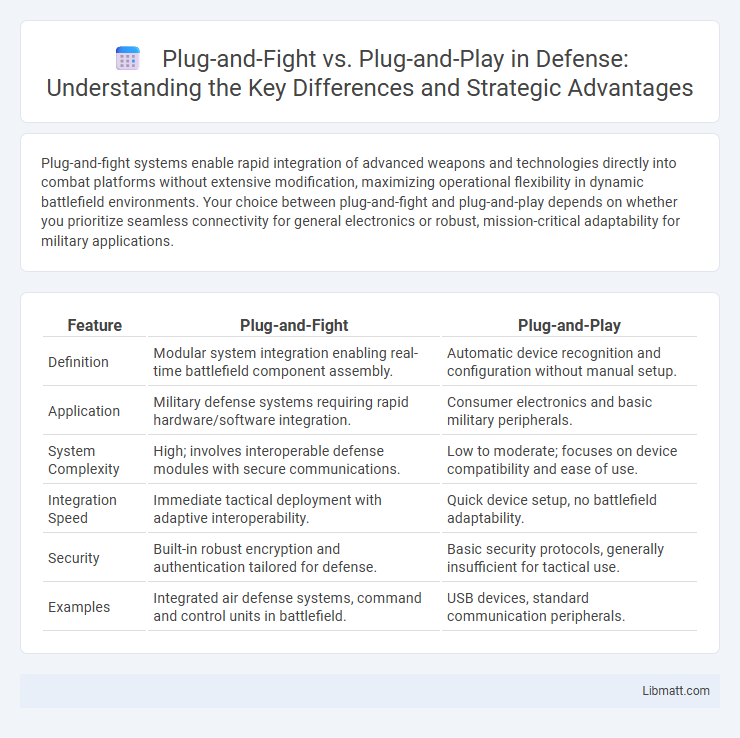Plug-and-fight systems enable rapid integration of advanced weapons and technologies directly into combat platforms without extensive modification, maximizing operational flexibility in dynamic battlefield environments. Your choice between plug-and-fight and plug-and-play depends on whether you prioritize seamless connectivity for general electronics or robust, mission-critical adaptability for military applications.
Table of Comparison
| Feature | Plug-and-Fight | Plug-and-Play |
|---|---|---|
| Definition | Modular system integration enabling real-time battlefield component assembly. | Automatic device recognition and configuration without manual setup. |
| Application | Military defense systems requiring rapid hardware/software integration. | Consumer electronics and basic military peripherals. |
| System Complexity | High; involves interoperable defense modules with secure communications. | Low to moderate; focuses on device compatibility and ease of use. |
| Integration Speed | Immediate tactical deployment with adaptive interoperability. | Quick device setup, no battlefield adaptability. |
| Security | Built-in robust encryption and authentication tailored for defense. | Basic security protocols, generally insufficient for tactical use. |
| Examples | Integrated air defense systems, command and control units in battlefield. | USB devices, standard communication peripherals. |
Introduction to Plug-and-Fight and Plug-and-Play
Plug-and-Fight is a tactical system architecture used primarily in military defense networks that emphasizes rapid integration and interoperability of combat systems, weapons, and sensors, allowing forces to quickly connect and coordinate without extensive configuration. Plug-and-Play refers to consumer electronics and computing devices designed to function immediately when connected, minimizing setup time and technical barriers. Both concepts streamline connectivity and functionality, but Plug-and-Fight specifically targets complex, mission-critical military applications, while Plug-and-Play focuses on ease of use in commercial technology.
Understanding Plug-and-Fight Systems
Plug-and-fight systems enable rapid integration of various defense assets like radar, missile launchers, and command centers into a unified network without interrupting ongoing operations, optimizing battlefield adaptability and situational awareness. Unlike plug-and-play technology, which focuses on simple device connection and automatic recognition in consumer electronics, plug-and-fight emphasizes secure, real-time data sharing and interoperability among complex military systems. This capability is critical for dynamic mission requirements, ensuring seamless communication and coordinated responses during active combat scenarios.
Core Principles of Plug-and-Play Technology
Plug-and-play technology is designed to enable seamless hardware integration by automatically detecting and configuring new devices without requiring manual driver installation or complex setup procedures. This technology relies on standardized interfaces and protocols like USB and PCI, allowing immediate device functionality upon connection. Core principles include simplicity, interoperability, and user-friendly deployment, ensuring devices work instantly with minimal user intervention.
Key Differences Between Plug-and-Fight and Plug-and-Play
Plug-and-fight systems emphasize real-time interoperability and seamless integration of military hardware components, enabling different units to connect and operate collectively during missions without pre-configuration, which is essential in defense environments. Plug-and-play technology centers on consumer electronics and general computing, allowing devices to automatically recognize and configure hardware without user intervention, enhancing convenience and ease of use. The core difference lies in plug-and-fight's focus on tactical, mission-critical system integration under active operational conditions, while plug-and-play prioritizes user-friendly device connectivity in commercial applications.
Application Areas: Military vs Civilian Use
Plug-and-fight technology is primarily utilized in military applications, enabling rapid integration and interoperability of combat systems for enhanced battlefield communication and coordination. Plug-and-play systems are predominantly employed in civilian contexts, facilitating easy installation and use of consumer electronics, IT hardware, and smart home devices without requiring specialized technical skills. The key distinction lies in the complexity and security requirements, with plug-and-fight designed for high-stakes, tactical environments and plug-and-play optimized for user-friendly, everyday technology interactions.
Benefits of Plug-and-Fight Mechanisms
Plug-and-fight mechanisms enable rapid integration of diverse military systems in dynamic combat environments, enhancing interoperability and mission adaptability. These mechanisms support real-time system reconfiguration without the need for extensive recalibration or downtime, significantly improving operational efficiency. Enhanced data sharing and coordinated command and control capabilities are direct benefits, ensuring seamless communication across networked platforms.
Advantages of Plug-and-Play Solutions
Plug-and-play solutions offer significant advantages by enabling immediate system integration without manual configuration, reducing setup time and operational costs. These systems enhance user experience through intuitive installation processes, allowing you to quickly add or replace components with minimal technical knowledge. Their scalability and compatibility across diverse devices ensure seamless interoperability and future-proofing for dynamic environments.
Challenges and Limitations in Adoption
Plug-and-fight systems face challenges in complex integration due to dependency on standardized communication protocols and secure real-time data exchange, which can hinder interoperability among diverse military platforms. In contrast, plug-and-play solutions encounter limitations in scalability and customization, often requiring extensive reconfiguration to adapt to specific operational environments and legacy systems. Both approaches struggle with ensuring robust cybersecurity measures and maintaining seamless functionality across evolving technological landscapes.
Future Trends in Interoperable Systems
Plug-and-fight systems emphasize real-time integration and adaptability in military operations, enabling seamless collaboration between diverse platforms and enhancing mission effectiveness. Plug-and-play technology focuses on ease of device integration and user-friendly interfaces, supporting rapid deployment in commercial and consumer environments. Your ability to leverage these future trends depends on adopting interoperable standards that facilitate both dynamic connectivity and straightforward device compatibility across evolving technological ecosystems.
Choosing the Right Approach for Your Needs
Plug-and-fight systems offer dynamic integration and real-time adaptability, ideal for complex military operations requiring seamless interoperability. Plug-and-play solutions provide straightforward, user-friendly connectivity and quick device setup, perfect for everyday consumer technology and basic network expansions. Selecting the right approach depends on your operational complexity and need for scalability, balancing advanced functionality with ease of use.
Plug-and-fight vs Plug-and-play Infographic

 libmatt.com
libmatt.com